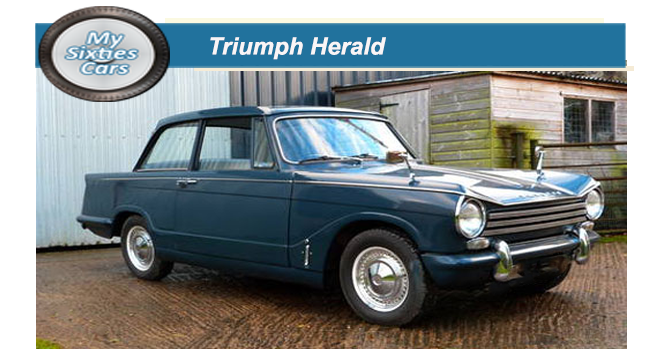 Compared with the dumpy Standard Eights and Tens which it replaced, the Triumph Herald was a totally different type of car.
Compared with the dumpy Standard Eights and Tens which it replaced, the Triumph Herald was a totally different type of car.
Styl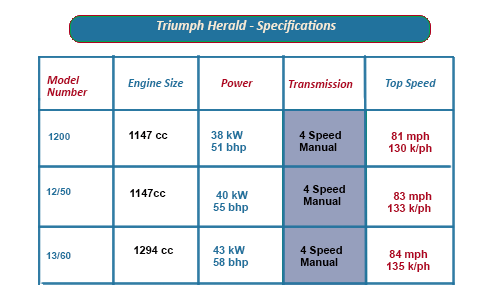 ish where the old Standards had been dull, and technically exciting where old Standards had been boring, the Herald was the first of a big family of saloons and sports cars which were tremedous commercial and critical success for Triumph during the Sixties.
ish where the old Standards had been dull, and technically exciting where old Standards had been boring, the Herald was the first of a big family of saloons and sports cars which were tremedous commercial and critical success for Triumph during the Sixties.
The Herald sold well for more than ten years.
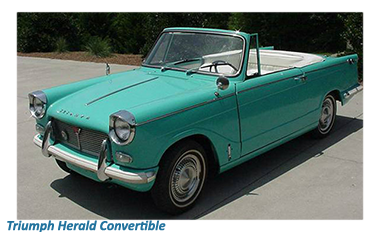 In 1957 the Herald's design (masterminded by Harry Webster) came together quickly, and by happenstance. Standard-Triumph wanted to build a conventional replacement for the Standard Eight/Ten using the same running gear but failed to source a supplier of unit-construction body shells.
In 1957 the Herald's design (masterminded by Harry Webster) came together quickly, and by happenstance. Standard-Triumph wanted to build a conventional replacement for the Standard Eight/Ten using the same running gear but failed to source a supplier of unit-construction body shells.
Electing to revert to separate-frame construction, Triumph took the dramatic step of hiring the services of a prodigiously talented young Italian, Giovanni Michelotti, to style the car, a project he took on with his usual flair.
Designing the Herald was the first step in a long cooperation between Triumph and Michelotti that continued through the Sixties.
From there onwards, it was a short step to adopting all-independent suspension, an unbeatable tight turning circle to decide to construct the body from bolt-up major sections.
Triumph encouraged Michelotti to develop an entire series of derivatives for the Herald, not only the standard two-door saloon, but also a coupe, estate car, and even a light van.
![]()
In their class, the original Heralds had competitive performance, but it was their styling which gave them a marketing advantage over their rivals, where cars like the Ford Anglia and (soon) the Vauxhall Viva looked ordinary by comparison.
The 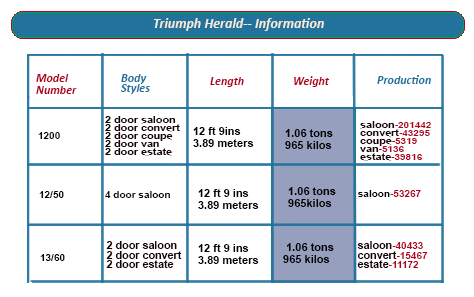 Triumph Herald series was an entirely new venture for Standard-Triumph, bringing with it some teething problems, although the car did come into it's with the launch of the larger-engined Herald 1200 in 1961.
Triumph Herald series was an entirely new venture for Standard-Triumph, bringing with it some teething problems, although the car did come into it's with the launch of the larger-engined Herald 1200 in 1961.
1200 was fitted with a large-bore 1147-cc version of the I-litre power unit and had 'Herald' lettering above the grille with a'1200' badge on the boot.
An attractive Walnut veneer fascia was introduced, while a lockable glove box, white rubber bumpers, improved seats with a fixed rear seat squab.
From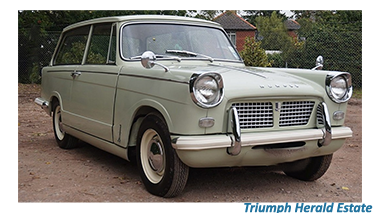 that point onwards the Triumph Herald's place in the market was assured, becoming increasingly popular, with demand peaking in the mid-Sixties
that point onwards the Triumph Herald's place in the market was assured, becoming increasingly popular, with demand peaking in the mid-Sixties
Encouraged by the success that the Herald was enjoying in the early Sixties, in 1963 Triumph launched another variant, the more powerful Herald 12/50.
Marketed only as a four-door saloon, the Herald 12/50 came fitted with a fold-back fabric sunroof as standard (a rare event in the UK of that time).
![]()
Powered by a 1147cc 51bhp engine, the 12/50 took the Herald into a different market sector, which Triumph would later go on to exploit in more depth with the launch of the Triumph Vitesse.
Released in March of 1963, the 12/50 remained in production until replaced by the up-rated 13/60 models in August 1967.
The 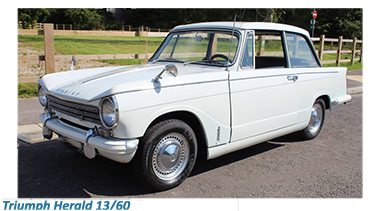 Herald’s immortality was assured even before the final models were produced in 1971.
Herald’s immortality was assured even before the final models were produced in 1971.
By this time they were 13/60s with 1.3-litre engines, the last separate-chassis cars on UK sale.
In later years, particularly in sporting form, the 11/60s became much sought-after classics.
The Herald range was one of the most successful compact familt saloons to come out of the UK un the Sixties, despite being strictly conventional in all but look.
Michelotti’s angular modern body, which allegedly took him just a matter of minutes to come up with the original design draft would evolve to a car that ; changed the face and fortune of Triumph in the Sixties.






